A safe environment is key for the client evidencing suicidal behaviour and/or ideation in the emergency department or on an inpatient unit. It is challenging to deal with all the safety risks that exist in within a hospital, as well as those brought in by clients and visitors. Staff should scan and/or evaluate the physical (built) environment and focus on what may pose an opportunity for harm. Safety begins with compiling a list of safety features within the inpatient facility. Following this, facilities should consider implementing risk-reduction strategies.
“Creep” factors:
Over time, activities, processes, procedures and even unit improvements can introduce a dangerous item to the client care environment (e.g. changes to the security department or building additions can increase the length of time for security to respond to a Code White). Creep factors also include what the clients, visitors or staff may bring on the units. Polices regarding storage of clients’ belongings and access to nonpatient areas (e.g. staff room, equipment room) may help to address these factors and should be developed with involvement of all staff members (e.g. allied health professionals, housekeeping, patient care aides, security, etc.)
Hanging Risks:
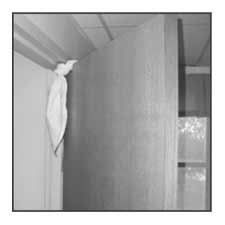
A knotted sheet can serve as a hanging risk when combined with solid core hospital doors on inpatient psychiatric units.

The combination of a sheet and solid core door will support the entire body weight off the ground.
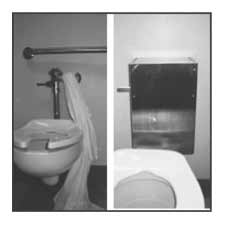
Plumbing fixtures pose risk but can be enclosed to minimize risk.
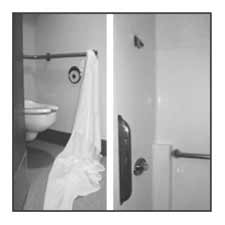
Grab bars standard for ADA (Americans with Disabilities Act) pose a hanging risk from a sitting position. These can be “plated” to minimize risk.
Potential Weapons:
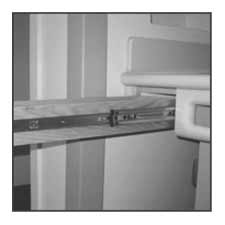
Cabinets can be taken apart to make weapons.
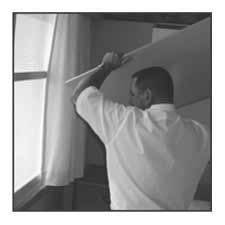
Heavy panels such as those from heating devices can be used to break windows or as a weapons against staff.
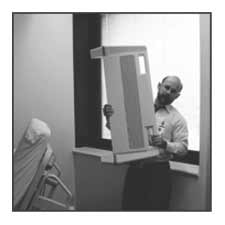
Some beds have removable headboards, which can be used as weapon against staff.
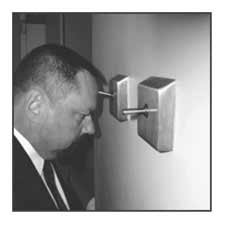
Even safety devices can pose a safety risk. Check all items, even those believed to be safe. In this example, safety hooks can cause a puncture wound.
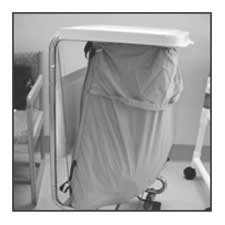
Common linen hamper can be broken down into several potential weapons.
Crush Risks:
Although manual beds have the advantage of not requiring cords, they may also present a crush risk.
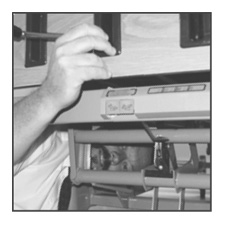
Be certain handles have been placed in a manner to minimize patient use to cause injury via crush points.
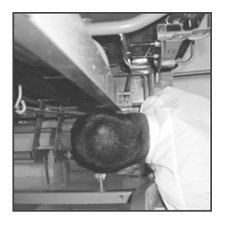
Bed frames should be check to assure safety stops are in place to minimize crush risk to patients.
Barricades:
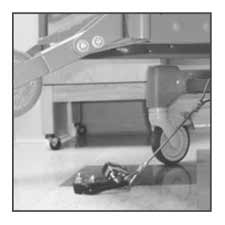
Bed is anchored and locked to the floor to prevent barricade situation. This is thought to be a safety feature.
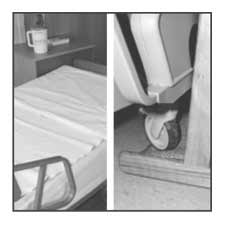
The same bed as in image on left hand side, combined with a nightstand and chair in the room can be used to create a barricade situation.
Other Considerations:
- Use plastic silverware and paper plates
- Ensure art work is securely attached to walls and not framed with glass (or use safety glass)
- Watch for tools or equipment left unattended (e.g. stethoscopes, brooms, etc.)
- Identify what the response time is for security to respond to psychiatric emergencies in the emergency department or psychiatry. Timed drills may be helpful.
- Safety rounds should be done regularly, at least weekly. Include “fresh” eyes (e.g. new staff or non-unit staff) when able.
Source: Yeager et al. (2005). Figures published with permission
